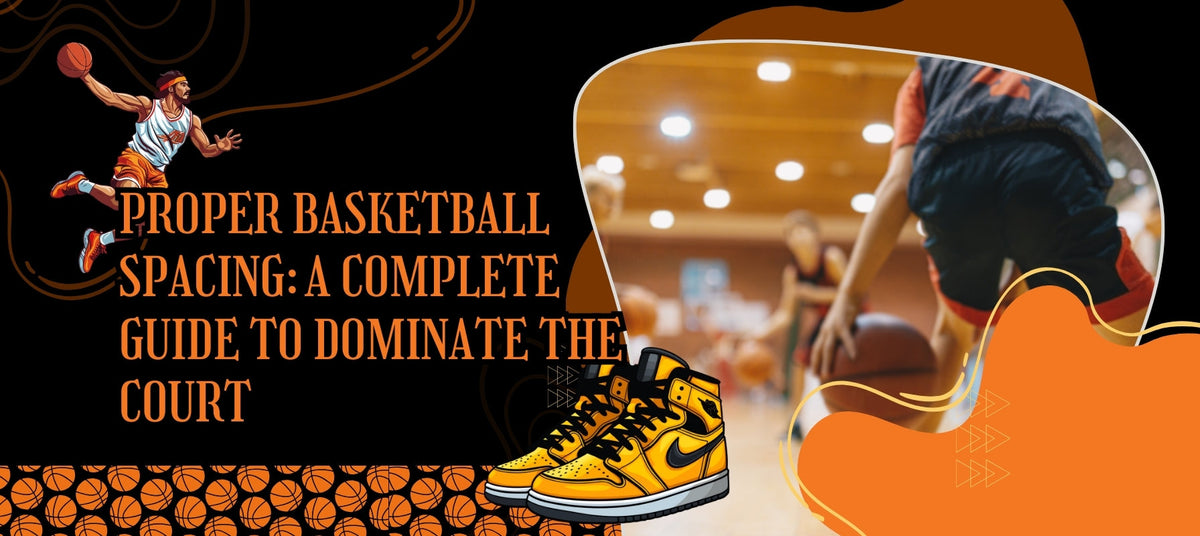
Proper Basketball Spacing: A Complete Guide to Dominate the Court
|
|
Time to read 5 min
|
|
Time to read 5 min
Proper basketball spacing is more than just a tactical nuance. It's the foundation of a fluid and successful offense. It dictates how easily you can pass, cut, screen, dribble, and shoot. Poor spacing often leads to a clunky offense full of turnovers, stifled plays, and missed opportunities. Achieving proper basketball spacing empowers your team to exploit defensive weaknesses, generate high-percentage shots, and control the pace of the game.
Have you ever watched a youth basketball game and felt like everyone was bunched up? That's the opposite of proper basketball spacing. It makes defending incredibly easy, as one defender can guard multiple players at once.
Imagine trying to dribble through a forest of elbows and covered passing lanes. That's what a lack of spacing feels like to a ball-handler. It kills offensive flow and frustrates even the most gifted players.
Think of the court as a delicately balanced ecosystem. Spacing isn’t about everyone standing far apart. It’s about strategic positioning that allows for player movement, opens passing lanes, and stretches the defense thin.
You want just the right distance between players to make the defense sweat. Good spacing on the court will spread the floor, making it more challenging to defend and limit offensive production. The areas of the court, which generally indicate good spacing include areas like the top, wings, corners, high posts, and low posts. that The areas of the court which generally indicate good spacing include areas like the top, wings, corners, high posts, and low posts.
Spacing in basketball offers various benefits. First, it allows players to move more freely and create passing options, allowing the offense to flow more smoothly. Also, by spreading the defense, it creates opportunities for cuts, drives to the basket, and open shots.
The most apparent benefit? Open shots. Good spacing forces the defense to cover more ground, leading to gaps and mismatches. That 3-pointer your shooting guard has been practicing suddenly looks a lot more appealing because the defender is too far away to contest. Coach Kelvin Sampson, in his book Spacing & Relocation, describes proper spacing as 'oxygen' for the offense.
Here are more ways good basketball spacing benefits your team:
Think about it – a defense has a much harder time defending against a team that effectively utilizes the entire court than a team that crowds the ball. Properly spacing your team makes it more difficult to guard because it forces the defense to make tougher decisions, react quicker, and work harder.
Coaches understand that one of their roles is to implement effective coaching strategies. Teaching proper basketball spacing is crucial for offensive success in basketball. Integrating spacing drills into practices helps reinforce the concept and develop a team's instinct to spread the floor.
As coaches, it’s not enough to tell your team to 'spread out.'. Use a variety of drills and coaching tools to teach and ingrain these skills. Some coaches find success by using visual aids, such as cones, to define where players should position themselves.
You might tell players to pretend they are 'in a bubble,' giving each other ample space. This strategy is very similar to what they have been doing in elementary school to socially distance themselves. Use lines on the court to help visualize these distances and get players comfortable with not crowding.
Some helpful drills for basketball spacing include:
There are several different transition offenses that a team might use, from hitting specific spots to a five-out spread. Teams like the Villanova Wildcats, famous for their 'four-out' offensive scheme, provide a perfect example. In this scheme, four players spread around the perimeter.
Implementing proper spacing into your offensive philosophy is an ongoing process. Incorporating it should occur across practices and drills. You want to develop an instinctive understanding of proper floor spacing among your players. Integrating spacing into shooting, passing, and scrimmage scenarios further ingrains these essential principles. This ensures that proper spacing isn’t just an abstract concept, it's second nature.
An excellent drill derived from Kelvin Sampson's 'Spacing & Relocation' uses two lines of players near the 'slots' (high post areas) and a third player positioned in a corner. One defender guards, focusing on proper closeout techniques. It emphasizes corner cuts and finding space to receive the pass for a high-percentage shot. This drill teaches offensive positioning and defensive tactics simultaneously.
There are tons of fantastic drills beyond just “spread out”. Some examples include “3-Man Weave Full Court”, “4-on-0 Fast Break”, “5-on-0 Fast Break”, “5-Man Passing”, “4 Corners”, “Cone Touch Spacing”, “4 out 1 in”, “3-on-2 Keep Away” and “4-on-3 Keep Away”. Check out #FindUseCreate on Twitter for more on these principles.
Understanding the critical elements of proper basketball spacing is crucial. These elements include player positioning, movement, court awareness, and the strategic use of screens and cuts. Don't underestimate it. By emphasizing these principles through focused drills, creating an offensive system that maximizes spacing, and developing strong communication between players, you'll be well on your way to building a cohesive and successful basketball team.
By dedicating time and attention to proper basketball spacing, both players and teams can reap tremendous rewards. Remember: When in doubt, space out.
Basketball Spacing. Basketball Spacing. Basketball Spacing.Basketball Spacing.Basketball Spacing.Basketball Spacing.Basketball Spacing.Basketball Spacing.Basketball Spacing.Basketball Spacing.Basketball Spacing.Basketball
This site requires cookies in order to provide all of its functionality.